Frequency Trend Analysis of Heavy Rainfall Days for Germany
Abstract
:1. Introduction
2. Materials and Methods
2.1. Multi-Decadal Trend Analyses of Heavy Rainfall Days
2.2. Uncertainty Assessments
2.2.1. Different Operating Periods
2.2.2. Location Shifts
2.2.3. Changed Reference Time for Daily Sums
2.3. Regional Trend Pattern
2.4. Rainfall Intensity
Ei = 0, if Ii < 0.05 mm h−1, or
Ei = 28.33 Pi, if Ii > 76.2 mm h−1
3. Results
3.1. Uncertainty Assessments
3.1.1. Operating Period
3.1.2. Location Shift
3.1.3. Reference Time
3.2. Regional Trend Pattern
3.3. Long-Term Trends for Selected Stations (20-mm Threshold)
3.4. Temporal Variability of Rainfall Erosivity—The Case Study Müncheberg
4. Discussion
4.1. Spatial and Temporal Trend Patterns
- The annual frequency of heavy rainfall days changed a little. Positive trends dominated for the 30 years between 1971 and 2000, which corresponded to an increase in summer and partly in winter. During the remaining CLINO periods, the variation of Kendall’s tau around zero was the result of opposed trends in both seasons.
- There was a weak increase in summer days, while winter days decreased. However, taking also the first half of the 20th century into consideration, these changes were within the range of previous CLINO periods.
- Most of them showed continuously positive winter trends, which corresponded to more winter precipitation, as observed by Pauling and Paeth [35]. However, the most recent data revealed balanced, even slightly negative trends.
- Despite significant differences in Kendall’s tau, the alternative thresholds of 10, 20, and 30 mm d−1 gave consistent results. The trends were more variable for the 10-mm threshold than for higher thresholds.
4.2. Reliability of Long-Term Trend Analyses
4.3. Rainfall Intensity and Erosivity
5. Conclusions
- For the whole of Germany, the trend variability after 1951 was within the range of previous changes.
- The direction and strength of multi-decadal trends of heavy rainfall days, however, varied in space and time. After 1951, stable positive trends occurred in southern and parts of northern Germany, but stable negative trends in Central Germany.
- Despite the frequent changes in the location of stations and in the reference time for daily sums, the trends could be considered reliable for regional to national studies. The impact of data inconsistency on the overall trend pattern was smaller than the threshold but varied among individual stations.
- Although not occurring more frequently, heavy rainfall events became more intense, and the average yearly erosivity was significantly higher during the last 20 years. Our results from NE Germany supported previous findings in other regions.
Author Contributions
Funding
Acknowledgments
Conflicts of Interest
Appendix A
| ID | Station Height (m) | Latitude | Longitude | Name | Data Availability |
|---|---|---|---|---|---|
| 23 | 8 | 53.0311 | 9.0233 | Achim-Embsen | 1901–2019 |
| 64 | 55 | 51.8506 | 12.0482 | Aken/Elbe | |
| 170 | 76 | 51.7309 | 13.0546 | Annaburg | |
| 198 | 164 | 51.3745 | 11.292 | Artern | |
| 349 | 630 | 47.7063 | 11.4139 | Benediktbeuern | |
| 371 | 82 | 54.4215 | 13.4379 | Bergen/Rügen | |
| 376 | 270 | 49.8981 | 10.0653 | Bergtheim | |
| 498 | 760 | 47.7453 | 8.3111 | Ühlingen-Birkendorf | |
| 647 | 592 | 49.9589 | 11.9125 | Brand/Oberpfalz | |
| 691 | 4 | 53.045 | 8.7979 | Bremen | |
| 722 | 1134 | 51.7986 | 10.6183 | Brocken | |
| 880 | 69 | 51.776 | 14.3168 | Cottbus | |
| 1107 | 346 | 49.852 | 10.499 | Ebrach | |
| 1166 | 105 | 51.4601 | 12.6692 | Eilenburg | |
| 1176 | 976 | 47.9634 | 8.2693 | Eisenbach | |
| 1235 | 525 | 47.9044 | 12.2977 | Endorf, Bad | |
| 1358 | 1213 | 50.4283 | 12.9535 | Fichtelberg | |
| 1517 | 38 | 52.3547 | 14.0638 | Fürstenwalde/Spree | |
| 1899 | 170 | 49.2858 | 9.1662 | Gundelsheim | |
| 2118 | 302 | 50.2553 | 10.6832 | Hellingen | |
| 2290 | 977 | 47.8009 | 11.0108 | Hohenpeißenberg | |
| 2444 | 155 | 50.9251 | 11.583 | Jena (Sternwarte) | |
| 2465 | 1 | 53.5083 | 9.7376 | Jork-Moorende | |
| 2559 | 705 | 47.7233 | 10.3348 | Kempten | |
| 2676 | 448 | 49.9461 | 11.1637 | Königsfeld, Kreis Bamberg | |
| 2908 | 7 | 53.2138 | 7.4742 | Leer | |
| 2928 | 138 | 51.3151 | 12.4462 | Leipzig-Holzhausen | |
| 3015 | 98 | 52.2085 | 14.118 | Lindenberg | |
| 3121 | 677 | 49.9113 | 12.5276 | Mähring | |
| 3126 | 76 | 52.1029 | 11.5827 | Magdeburg | |
| 3188 | 549 | 50.1141 | 11.9712 | Marktleuthen-Neudorf | |
| 3271 | 313 | 48.8548 | 12.9189 | Metten | |
| 3279 | 173 | 51.0452 | 12.2989 | Meuselwitz | |
| 3280 | 98 | 53.3083 | 12.2937 | Meyenburg | |
| 3364 | 286 | 50.8681 | 10.8211 | Drei Gleichen-Mühlberg | |
| 3424 | 624 | 47.6689 | 11.2238 | Murnau | |
| 3426 | 127 | 51.566 | 14.7008 | Muskau, Bad | |
| 3564 | 35 | 53.4571 | 11.5687 | Neustadt-Glewe-Friedrichsmoor | |
| 3685 | 431 | 49.4114 | 10.4331 | Oberdachstetten | |
| 3761 | 276 | 49.207 | 9.5176 | Öhringen | |
| 3946 | 386 | 50.4819 | 12.13 | Plauen | |
| 3987 | 81 | 52.3813 | 13.0622 | Potsdam | |
| 4064 | 409 | 48.6921 | 10.8976 | Rain am Lech | |
| 4081 | 30 | 52.6092 | 12.3628 | Rathenow | |
| 4103 | 582 | 48.9662 | 13.1425 | Regen | |
| 4106 | 345 | 49.1388 | 12.1164 | Regenstauf | |
| 4275 | 32 | 53.1288 | 9.3398 | Rotenburg (Wümme) | |
| 4287 | 415 | 49.3848 | 10.1732 | Rothenburg ob der Tauber | |
| 4381 | 179 | 51.4776 | 11.3123 | Sangerhausen | |
| 4625 | 59 | 53.6425 | 11.3872 | Schwerin | |
| 4745 | 75 | 52.9604 | 9.793 | Soltau | |
| 4902 | 13 | 54.2966 | 13.0615 | Stralsund | |
| 5009 | 38 | 53.761 | 12.5574 | Teterow | |
| 5127 | 649 | 48.0083 | 8.8179 | Tuttlingen | |
| 5142 | 1 | 53.7444 | 14.0697 | Ueckermünde | |
| 5389 | 664 | 48.5962 | 13.7864 | Wegscheid | |
| 5442 | 109 | 51.2002 | 11.9154 | Weißenfels | |
| 5444 | 500 | 48.3091 | 10.2048 | Weißenhorn-Oberreichenbach | |
| 5483 | 255 | 51.1498 | 7.1867 | Wermelskirchen | |
| 5513 | 92 | 52.2902 | 7.8687 | Westerkappeln | |
| 5542 | 90 | 50.0421 | 8.2331 | Wiesbaden-Biebrich | |
| 5643 | 66 | 53.1864 | 12.4949 | Wittstock-Rote Mühle | |
| 5732 | 8 | 54.6928 | 8.5271 | Wrixum/Föhr | |
| 5777 | 1 | 54.4317 | 12.6837 | Zingst, Ostseeheilbad | |
| 5792 | 2964 | 47.4209 | 10.9847 | Zugspitze | |
| 5941 | 686 | 47.6754 | 12.4698 | Reit im Winkl | |
| 317 | 710 | 49.1198 | 13.1987 | Bayerisch Eisenstein | 1901–2010 |
| 733 | 370 | 49.2518 | 12.311 | Bruck | |
| 892 | 2 | 53.8256 | 8.7721 | Cuxhaven-Altenbruch | |
| 999 | 15 | 54.1137 | 11.9129 | Doberan, Bad | |
| 1274 | 450 | 48.6662 | 12.1766 | Ergoldsbach-Kläham | |
| 1480 | 8 | 53.4818 | 7.7274 | Friedeburg-Wiesedermeer | |
| 1610 | 200 | 50.891 | 12.0641 | Gera-Untermhaus | |
| 1840 | 490 | 50.8127 | 13.3425 | Großhartmannsdorf/Speicher | |
| 1915 | 155 | 51.359 | 14.8609 | Hähnichen | |
| 2004 | 46 | 54.1245 | 9.407 | Hanerau-Hademarschen | |
| 2203 | 66 | 51.1687 | 6.9621 | Hilden | |
| 2237 | 28 | 53.1506 | 11.0411 | Hitzacker | |
| 2322 | 204 | 49.782 | 9.6783 | Holzkirchen/Unterfranken | |
| 2403 | 731 | 47.5566 | 10.223 | Immenstadt | |
| 2522 | 112 | 49.0382 | 8.3641 | Karlsruhe | |
| 2624 | 32 | 54.533 | 9.9855 | Kleinwaabs | |
| 2786 | 470 | 50.1378 | 11.5742 | Kupferberg | |
| 2797 | 11 | 52.6152 | 6.7443 | Laar, Kreis Grafschaft Bentheim | |
| 2824 | 150 | 49.1958 | 8.0972 | Landau/Pfalz | |
| 2878 | 118 | 51.391 | 11.8788 | Lauchstädt, Bad | |
| 3189 | 730 | 47.781 | 10.6166 | Marktoberdorf | |
| 3293 | 590 | 48.0649 | 10.4835 | Mindelheim | |
| 3375 | 572 | 50.1771 | 11.7686 | Münchberg-Straas | |
| 3628 | 2 | 53.6031 | 7.2123 | Norden | |
| 4236 | 480 | 48.7532 | 13.4983 | Röhrnbach | |
| 4237 | 300 | 50.396 | 10.5323 | Römhild | |
| 4496 | 95 | 51.6826 | 12.7348 | Schmiedeberg, Bad | |
| 5155 | 567 | 48.3837 | 9.9524 | Ulm | |
| 5193 | 617 | 47.8669 | 11.7847 | Valley-Mühlthal | |
| 5344 | 2 | 53.7865 | 7.9096 | Wangerooge | |
| 5565 | 33 | 52.891 | 8.4254 | Wildeshausen | |
| 5653 | 465 | 49.2553 | 10.2469 | Wörnitz | |
| 5776 | 54 | 52.2694 | 12.2901 | Ziesar | |
| 822 | 205 | 51.2066 | 14.2371 | Burkau-Kleinhänchen | 1911–2019 |
| 1197 | 460 | 48.9895 | 10.1312 | Ellwangen-Rindelbach | |
| 1470 | 863 | 48.4652 | 8.3026 | Freudenstadt-Kniebis | |
| 2562 | 428 | 51.334 | 10.529 | Helbedündorf-Keula | |
| 3179 | 317 | 49.666 | 10.3851 | Markt Bibart | |
| 3247 | 567 | 48.0557 | 9.3185 | Mengen-Ennetach | |
| 3257 | 250 | 49.4773 | 9.7622 | Mergentheim, Bad-Neunkirchen | |
| 1001 | 97 | 51.6451 | 13.5747 | Doberlug-Kirchhain | 1901–2019 with one missing CLINO period |
| 1514 | 53 | 53.1986 | 13.1513 | Fürstenberg/Havel | |
| 2887 | 167 | 51.2671 | 13.8469 | Laußnitz-Glauschnitz | |
| 3297 | 64 | 53.2681 | 12.7221 | Krümmel | |
| 3469 | 48 | 53.9043 | 11.8863 | Bernitt |
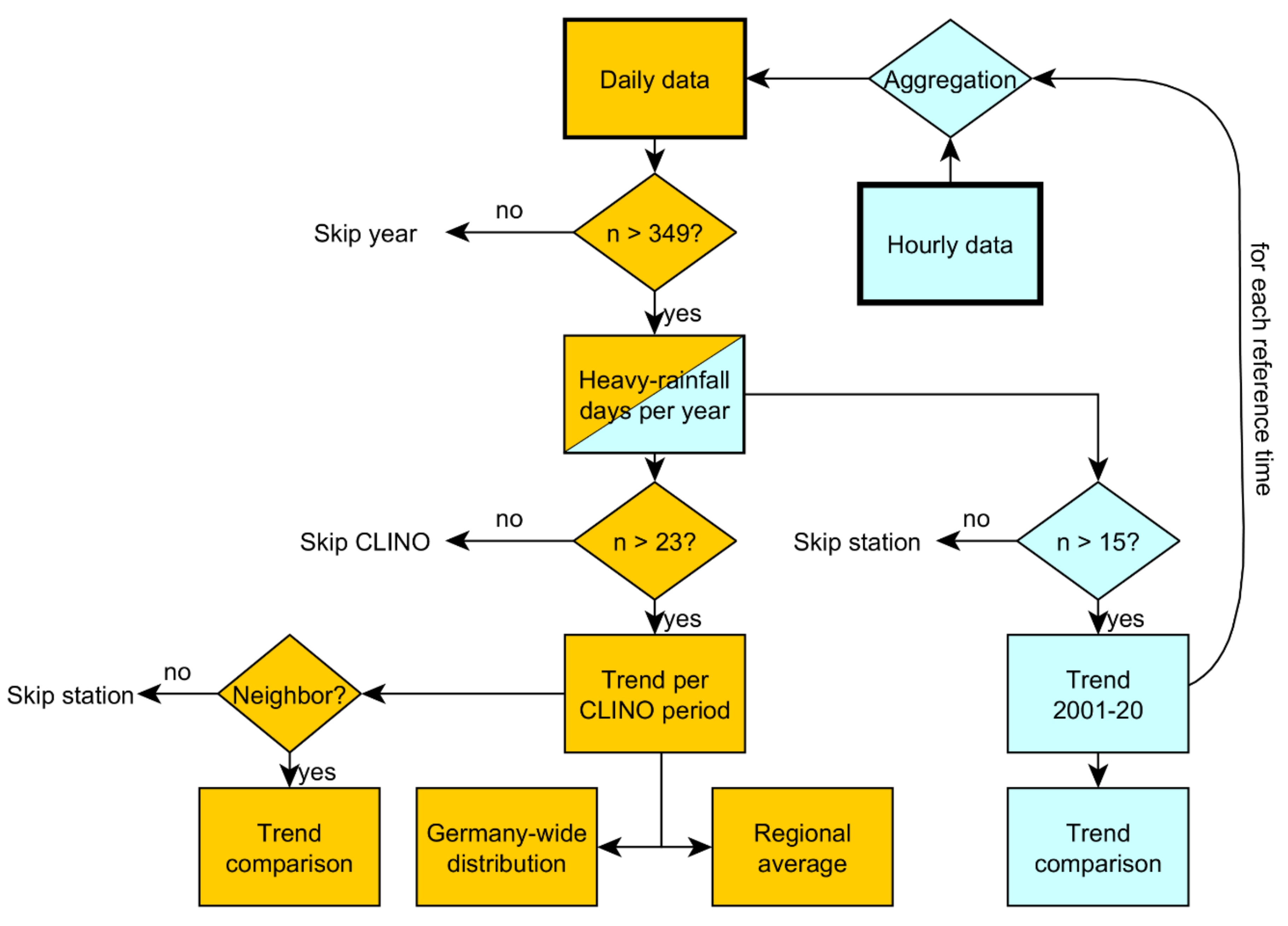
Appendix B
| Schleswig-Holsteinische Marschen (und Nordseeinseln) | Odertal | Fläming | Elbe-Mulde-Tiefland | Lausitzer Becken und Heideland | Mitteldeutsches Schwarzerdegebiet | Oberlausitz | Westerwald | Taunus | Rhein-Main-Tiefland | Moseltal | Meinfränkische Platten | Fränkische Alb (Frankenalb) | Schwäbisches Keuper-Lias-Land | Isar-Inn-Schotterplatten | Geuplatten im Neckar- und Tauberland | Schwarzwald | Schwäbische Alb (Schwabenalb) | Mittelbrandenburgische Platten und Niederungen | Rückland der Mecklenburgischen Seenplatte | Mecklenburgisch-Vorpommersches Küstengebiet | Oberpfälzisch-Obermainisches Hügelland | Nordbrandenburgisches Platten- und Hügelland | Altmark | |
|---|---|---|---|---|---|---|---|---|---|---|---|---|---|---|---|---|---|---|---|---|---|---|---|---|
| average tau for 5 CLINO-periods | ||||||||||||||||||||||||
| 1951–1980 | 0.032 | −0.079 | −0.130 | −0.084 | −0.090 | −0.105 | −0.076 | 0.016 | 0.030 | 0.005 | 0.011 | 0.164 | 0.042 | 0.079 | 0.022 | 0.050 | 0.076 | −0.107 | 0.079 | 0.079 | −0.101 | −0.148 | 0.021 | 0.095 |
| 1961–1990 | 0.007 | −0.007 | −0.077 | −0.020 | −0.078 | −0.062 | −0.041 | 0.090 | 0.038 | 0.096 | 0.007 | 0.180 | 0.134 | 0.120 | 0.006 | 0.033 | 0.049 | −0.042 | 0.157 | 0.132 | −0.130 | −0.151 | 0.073 | 0.154 |
| 1971–2000 | 0.067 | −0.008 | −0.065 | −0.058 | −0.002 | −0.002 | −0.009 | 0.085 | 0.037 | 0.125 | 0.004 | 0.009 | 0.050 | 0.059 | 0.020 | 0.139 | 0.023 | −0.047 | 0.042 | 0.115 | −0.038 | −0.032 | 0.046 | 0.013 |
| 1981–2010 | 0.020 | 0.123 | 0.026 | 0.000 | 0.025 | 0.018 | −0.020 | −0.182 | 0.122 | −0.179 | 0.035 | −0.114 | −0.008 | 0.013 | 0.025 | −0.100 | −0.050 | 0.074 | −0.041 | −0.011 | 0.115 | 0.100 | −0.110 | −0.025 |
| 1991–2019 | 0.099 | 0.034 | 0.109 | 0.029 | 0.010 | 0.045 | 0.032 | −0.161 | −0.034 | 0.010 | 0.014 | −0.035 | 0.059 | −0.058 | −0.074 | −0.031 | −0.004 | 0.126 | 0.004 | −0.059 | 0.101 | 0.132 | −0.035 | −0.065 |
| trend direction (1 - positive trend; 2 - negative trend) for 5 CLINO-periods | ||||||||||||||||||||||||
| 1951–1980 | 1 | 2 | 2 | 2 | 2 | 2 | 2 | 1 | 1 | 1 | 1 | 1 | 1 | 1 | 1 | 1 | 1 | 2 | 1 | 1 | 2 | 2 | 1 | 1 |
| 1961–1990 | 1 | 2 | 2 | 2 | 2 | 2 | 2 | 1 | 1 | 1 | 1 | 1 | 1 | 1 | 1 | 1 | 1 | 2 | 1 | 1 | 2 | 2 | 1 | 1 |
| 1971–2000 | 1 | 2 | 2 | 2 | 2 | 2 | 2 | 1 | 1 | 1 | 1 | 1 | 1 | 1 | 1 | 1 | 1 | 2 | 1 | 1 | 2 | 2 | 1 | 1 |
| 1981–2010 | 1 | 1 | 1 | 2 | 1 | 1 | 2 | 2 | 1 | 2 | 1 | 2 | 2 | 1 | 1 | 2 | 2 | 1 | 2 | 2 | 1 | 1 | 2 | 2 |
| 1991–2019 | 1 | 1 | 1 | 1 | 1 | 1 | 1 | 2 | 2 | 1 | 1 | 2 | 1 | 2 | 2 | 2 | 2 | 1 | 1 | 2 | 1 | 1 | 2 | 2 |
| continuously positive (1) or negative (2) trends for 3 periods | ||||||||||||||||||||||||
| 1961–2010 | 1 | 2 | 2 | 2 | 2 | 2 | 2 | 1 | 1 | 1 | 1 | 1 | 1 | 1 | 1 | 1 | 1 | 2 | 1 | 1 | 2 | 2 | 1 | 1 |
| 1951–2010 | 1 | 2 | 2 | 1 | 1 | 1 | 1 | |||||||||||||||||
| 1951–2019 | 1 | 1 | ||||||||||||||||||||||
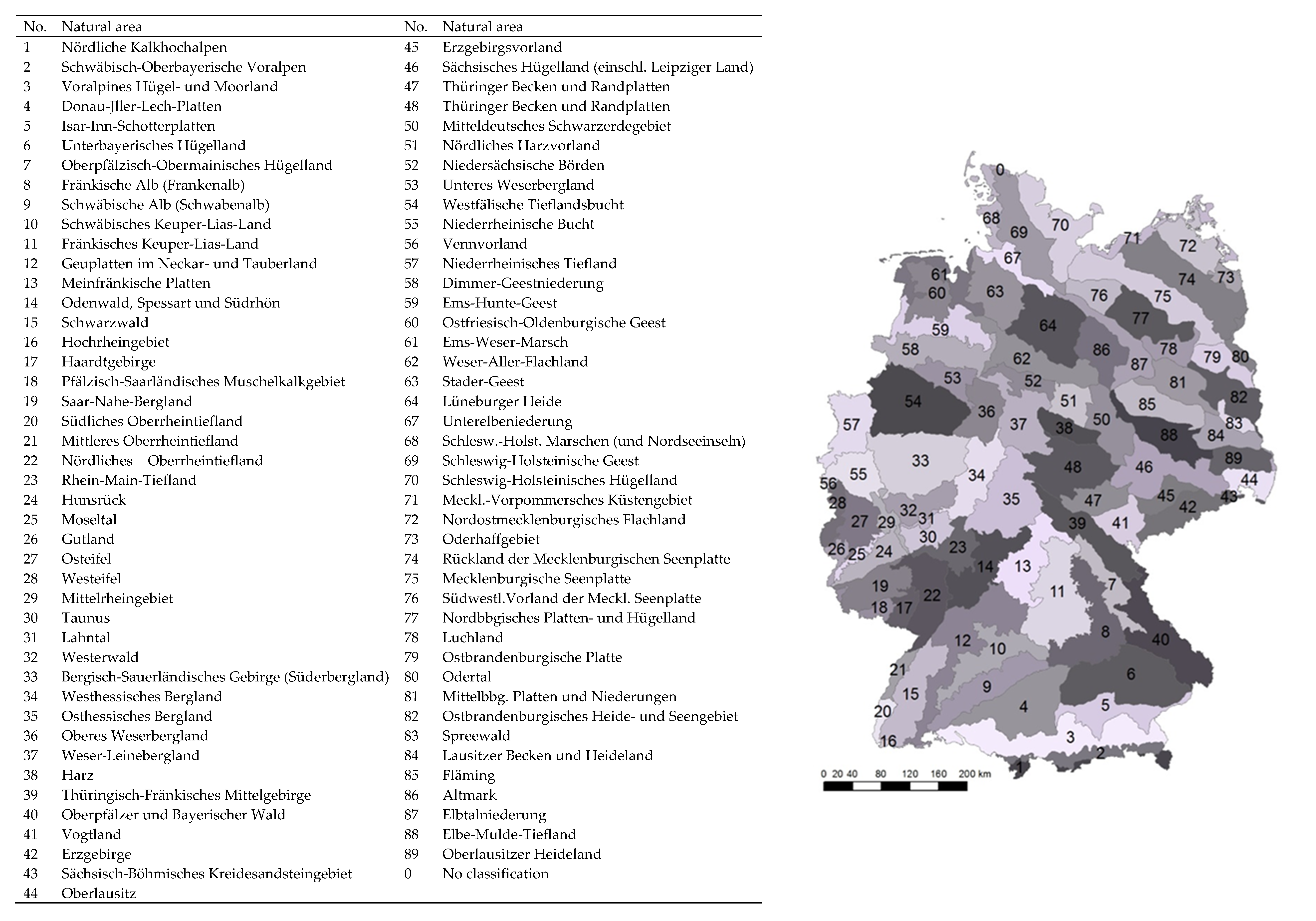
Appendix C

References
- Dole, R.; Hoerling, M.; Schubert, S. Reanalysis of Historical Climate Data for Key Atmospheric Features: Implications for Attribution of Causes of Observed Change; CCSP: Asheville, NC, USA, 2008; p. 156. [Google Scholar]
- Auerswald, K.; Fischer, F.K.; Kistler, M.; Treisch, M.; Maier, H.; Brandhuber, R. Behavior of farmers in regard to erosion by water as reflected by their farming practices. Sci. Total Environ. 2018, 613–614, 1–9. [Google Scholar] [CrossRef] [PubMed]
- Klein Tank, A.M.G.; Zwiers, F.W.; Zhang, X. Guidelines on Analysis of Extremes in a Changing Climate in Support of Informed Decisions for Adaptation; World Meteorological Organization: Geneva, Switzerland, 2009; p. 56. [Google Scholar]
- Wiemann, S.; Al Janabi, F.; Eltner, A.; Krüger, R.; Luong, T.; Sardemann, H.; Singer, T.; Spieler, D.; Kronenberg, R. Entwicklung eines Informationssystems zur Analyse und Vorhersage hydro- meteorologischer Extremereignisse in mittleren und kleinen Einzugsgebieten. Forum Hydrol. Wasserbewirtsch. 2018, 39, 357–367. [Google Scholar]
- DWD. Deutscher Wetterdienst zur Pflanzenentwicklung im Sommer 2017. Available online: https://www.dwd.de/DE/presse/pressemitteilungen/DE/2017/20170926_agrarwetter_sommer_news.html (accessed on 20 November 2019).
- GDV. Forschungsprojekt Starkregen. Available online: https://www.gdv.de/de/themen/news/forschungsprojekt-starkregen-52866 (accessed on 25 November 2019).
- Hapuarachchi, H.A.P.; Wang, Q.J.; Pagano, T.C. A review of advances in flash flood forecasting. Hydrol. Process. 2011, 25, 2771–2784. [Google Scholar] [CrossRef]
- Montgomery, D. Dreck: Warum Unsere Zivilisation den Boden unter den Füßen Verliert (Dirt: The Erosion of Civilization); Oekom: München, Germany, 2010; p. 352. [Google Scholar]
- Keesstra, S.; Mol, G.; de Leeuw, J.; Okx, J.; Molenaar, C.; de Cleen, M.; Visser, S. Soil-Related Sustainable Development Goals: Four Concepts to Make Land Degradation Neutrality and Restoration Work. Land 2018, 7, 133. [Google Scholar] [CrossRef] [Green Version]
- FAO. Outcome document of the Global Symposium on Soil Erosion; Food and Agriculture Organization: Rome, Italy, 2019; p. 28. [Google Scholar]
- Bender, S.; Schaller, M. Vergleichendes Lexikon. Wichtige Definitionen, Schwellenwerte, Kenndaten und Indices für Fragestellungen Rund um das Thema Klimawandel und Seine Folgen. Available online: https://www.climate-service-center.de/imperia/md/content/csc/lexikon_definitionen_mit_cover.pdf (accessed on 25 August 2019).
- Łupikasza, E.B.; Hänsel, S.; Matschullat, J. Regional and seasonal variability of extreme precipitation trends in southern Poland and central-eastern Germany 1951–2006. Int. J. Climatol. 2011, 31, 2249–2271. [Google Scholar] [CrossRef]
- Deumlich, D. Erosive Niederschläge und ihre Eintrittswahrscheinlichkeit im Nordosten Deutschlands. Meteorol. Z. 1999, 8, 155–161. [Google Scholar] [CrossRef]
- SMUL. NEYMO—Lausitzer Neiße/Nysa Łużycka. Available online: https://www.umwelt.sachsen.de/umwelt/wasser/neymo/ergebnisse_klima_methoden.htm (accessed on 25 February 2020).
- Deumlich, D.; Gödecke, K. Untersuchungen zu Schwellenwerten erosionsauslösender Niederschläge im Jungmoränengebiet der DDR. Arch. Acker Pflanzenbau Bodenkd. 1989, 33, 709–716. [Google Scholar]
- Jung, L.; Brechtel, R. Messungen von Oberflächenabfluss auf Verschiedenen Böden der BRD; DVWK: Bonn, Germany, 1980; p. 48. [Google Scholar]
- DWD. Warnkriterien. Available online: https://www.dwd.de/DE/wetter/warnungen_aktuell/kriterien/warnkriterien.html (accessed on 23 January 2020).
- IPCC. Managing the Risks of Extreme Events and Disasters to Advance Climate Change Adaptation; Cambridge University Press: Cambridge, UK, 2012; pp. 1–19. [Google Scholar]
- Madsen, H.; Lawrence, D.; Lang, M.; Martinkova, M.; Kjeldsen, T.R. Review of trend analysis and climate change projections of extreme precipitation and floods in Europe. J. Hydrol. 2014, 519, 3634–3650. [Google Scholar] [CrossRef] [Green Version]
- Zolina, O. Change in intense precipitation in Europe. In Changes in Flood Risk in Europe; Kundzewicz, Z.W., Ed.; IAHS Press: Wallingford, UK, 2012; pp. 97–120. [Google Scholar]
- HLNUG. Regionale Klimaprojektionen Ensemble für Deutschland (ReKliEs-De). Available online: http://reklies.hlnug.de/home/ (accessed on 23 January 2020).
- Fiener, P.; Neuhaus, P.; Botschek, J. Long-term trends in rainfall erosivity-analysis of high resolution precipitation time series (1937–2007) from Western Germany. Agric. For. Meteorol. 2013, 171, 115–123. [Google Scholar] [CrossRef]
- Zolina, O.; Simmer, C.; Kapala, A.; Bachner, S.; Gulev, S.; Maechel, H. Seasonally dependent changes of precipitation extremes over Germany since 1950 from a very dense observational network. J. Geophys. Res. Atmos. 2008, 113. [Google Scholar] [CrossRef]
- Zolina, O. Multidecadal trends in the duration of wet spells and associated intensity of precipitation as revealed by a very dense observational German network. Environ. Res. Lett. 2014, 9, 025003. [Google Scholar] [CrossRef]
- Auerswald, K.; Fischer, F.K.; Winterrath, T.; Brandhuber, R. Rain erosivity map for Germany derived from contiguous radar rain data. Hydrol. Earth Syst. Sci. 2019, 23, 1819–1832. [Google Scholar] [CrossRef] [Green Version]
- Hanel, M.; Pavlaskova, A.; Kysely, J. Trends in characteristics of sub-daily heavy precipitation and rainfall erosivity in the Czech Republic. Int. J. Climatol. 2016, 36, 1833–1845. [Google Scholar] [CrossRef]
- CDC (Climate Data Center). Historical Daily Precipitation Observations for Germany, Offenbach, Germany. Available online: https://opendata.dwd.de/climate_environment/CDC/ (accessed on 15 January 2020).
- WMO. WMO Guidelines on the Calculation of Climate Normals; WMO: Geneva, Switzerland, 2017; Volume 1203, p. 18. [Google Scholar]
- Marchetto, A. rkt: Mann-Kendall Test, Seasonal and Regional Kendall Tests, Version 1.5. Available online: https://CRAN.R-project.org/package=rkt (accessed on 15 February 2020).
- Zolina, O.; Simmer, C.; Belyaev, K.; Gulev, S.K.; Koltermann, P. Changes in the Duration of European Wet and Dry Spells during the Last 60 Years. J. Clim. 2013, 26, 2022–2047. [Google Scholar] [CrossRef]
- Pebesma, E. Simple Features for R: Standardized Support for Spatial Vector Data. R J. 2018, 10. [Google Scholar] [CrossRef] [Green Version]
- CDC. Historical Hourly Station Observations of Precipitation for Germany Version v006. Available online: https://opendata.dwd.de/climate_environment/CDC/observations_germany/climate/hourly/precipitation/historical/ (accessed on 7 April 2020).
- Meynen, E.; Schmithüsen, J. Handbuch der Naturräumlichen Gliederung Deutschlands/unter Mitwirkung des Zentralausschusses für Deutsche Landeskunde hrsg. von E. Meynen; Bundesanstalt für Landeskunde u. Raumforschung: Bad Godesberg, Germany, 1962; Volume 1, pp. 1953–1962. [Google Scholar]
- Schwertmann, U.; Vogl, W.; Kainz, M. Bodenerosion durch Wasser: Vorhersage des Abtrags und Bewertung von Gegenmaßnahmen; Eugen Ulmer: Stuttgart, Germany, 1987; p. 64. [Google Scholar]
- Pauling, A.; Paeth, H. On the variability of return periods of European winter precipitation extremes over the last three centuries. Clim. Past 2007, 3, 65–76. [Google Scholar] [CrossRef] [Green Version]
- Beranova, R.; Kysely, J. Trends of precipitation characteristics in the Czech Republic over 1961-2012, their spatial patterns and links to temperature and the North Atlantic Oscillation. Int. J. Climatol. 2018, 38, E596–E606. [Google Scholar] [CrossRef]
- Murawski, A.; Zimmer, J.; Merz, B. High spatial and temporal organization of changes in precipitation over Germany for 1951-2006. Int. J. Climatol. 2016, 36, 2582–2597. [Google Scholar] [CrossRef] [Green Version]
- Pińskwar, I.; Choryński, A.; Graczyk, D.; Kundzewicz, Z.W. Observed changes in extreme precipitation in Poland: 1991–2015 versus 1961–1990. Theor. Appl. Climatol. 2018, 135, 773–787. [Google Scholar] [CrossRef] [Green Version]
- Trömel, S.; Schönwiese, C.D. Probability change of extreme precipitation observed from 1901 to 2000 in Germany. Theor. Appl. Climatol. 2006, 87, 29–39. [Google Scholar] [CrossRef]
- Fischer, F.; Hauck, J.; Brandhuber, R.; Weigl, E.; Maier, H.; Auerswald, K. Spatio-temporal variability of erosivity estimated from highly resolved and adjusted radar rain data (RADOLAN). Agric. For. Meteorol. 2016, 223, 72–80. [Google Scholar] [CrossRef]
- Fiener, P.; Auerswald, K. Spatial variability of rainfall on a sub-kilometre scale. Earth Surf. Process. Landf. 2009, 34, 848–859. [Google Scholar] [CrossRef] [Green Version]
- Fabig, I. Die Niederschlags und Starkregenentwicklung der letzten 100 Jahre im Mitteldeutschen Trockengebiet als Indikatoren Möglicher Klimaänderungen. In Dissertation; Halle University: Halle, Germany, 2007. [Google Scholar]
- Neuhaus, P.; Fiener, P.; Botschek, J. Einfluss des Globalen Klimawandels auf die Räumliche und Zeitliche Variabilität der Niederschlagserosivität in NRW.; LANU: Recklinghausen, Germany, 2010; p. 89. [Google Scholar]
- Rudolf, B.; Rapp, J. Das Jahrhunderthochwasser der Elbe: Synoptische Wetterentwicklung und Klimatologische Aspekte; DWD: Offenbach, Germany, 2002; pp. 172–187. [Google Scholar]
- Grassl, H.; Vieser, H. Des Menschen gefährlichstes Experiment: Dürre, Flut und Stürme. Bild Wiss. 1988, 11, 61–72. [Google Scholar]
- Mullan, D.; Favis-Mortlock, D.; Fealy, R. Addressing key limitations associated with modelling soil erosion under the impacts of future climate change. Agric. For. Meteorol. 2012, 156, 18–30. [Google Scholar] [CrossRef] [Green Version]
- Rahmstorf, S.; Coumou, D. Increase of extreme events in a warming world. Proc. Natl. Acad. Sci. USA 2011, 108, 17905–17909. [Google Scholar] [CrossRef] [Green Version]
- Gericke, A.; Kiesel, J.; Deumlich, D.; Venohr, M. Recent and Future Changes in Rainfall Erosivity and Implications for the Soil Erosion Risk in Brandenburg, NE Germany. Water 2019, 11, 904. [Google Scholar] [CrossRef] [Green Version]
- Winterrath, T.; Brendel, C.; Hafer, M.; Junghänel, T.; Klameth, A.; Walawender, E.; Weigl, E.; Becker, A. Erstellung Einer Radargestützten Niederschlagsklimatologie; Deutscher Wetterdienst: Offenbach, Germany, 2017; p. 72. [Google Scholar]
- Van den Besselaar, E.J.M.; Klein Tank, A.M.G.; Buishand, T.A. Trends in European precipitation extremes over 1951–2010. Int. J. Climatol. 2013, 33, 2682–2689. [Google Scholar] [CrossRef]
- Panagos, P.; Ballabio, C.; Meusburger, K.; Spinoni, J.; Alewell, C.; Borrelli, P. Towards estimates of future rainfall erosivity in Europe based on REDES and WorldClim datasets. J. Hydrol. 2017, 548, 251–262. [Google Scholar] [CrossRef] [PubMed]
- Routschek, A.; Schmidt, J.; Kreienkamp, F. Impact of climate change on soil erosion—A high-resolution projection on catchment scale until 2100 in Saxony/Germany. Catena 2014, 121, 99–109. [Google Scholar] [CrossRef]
- Stott, P.A.; Christidis, N.; Otto, F.E.; Sun, Y.; Vanderlinden, J.P.; van Oldenborgh, G.J.; Vautard, R.; von Storch, H.; Walton, P.; Yiou, P.; et al. Attribution of extreme weather and climate-related events. Wiley Interdiscip. Rev. Clim. Chang. 2016, 7, 23–41. [Google Scholar] [CrossRef]
- Otte, I. Mit mehr Daten zu einer besseren Einschätzung der Starkniederschläge. In Proceedings of the 13 Klimatagung, Offenbach, Germany, 19 November 2019. [Google Scholar]
- Mächel, H.; Kapala, A.; Behrendt, J.; Simmer, C. Rettung historischer Klimadaten in Deutschland. Mitt. DMG 2009, 3, 4–7. [Google Scholar]
- Tan, L.S.; Burton, S.; Crouthamel, R.; van Engelen, A.; Hutchinson, R.; Nicodemus, L.; Peterson, T.C.; Rahimzadeh, F. Guidelines on Climate Data Rescue; Llansó, P., Kontongomde, H., Eds.; WMO: Geneva, Switzerland, 2004. [Google Scholar]
- Paalzow, Mr. Atmospheric Precipitation to Prenzlow in the Uckermark during the three summer months June, July, August 1857; measured by Mr. Mangelsdorf, Weise, and Zander. Available in the Brandenburg State Archive. 1857.



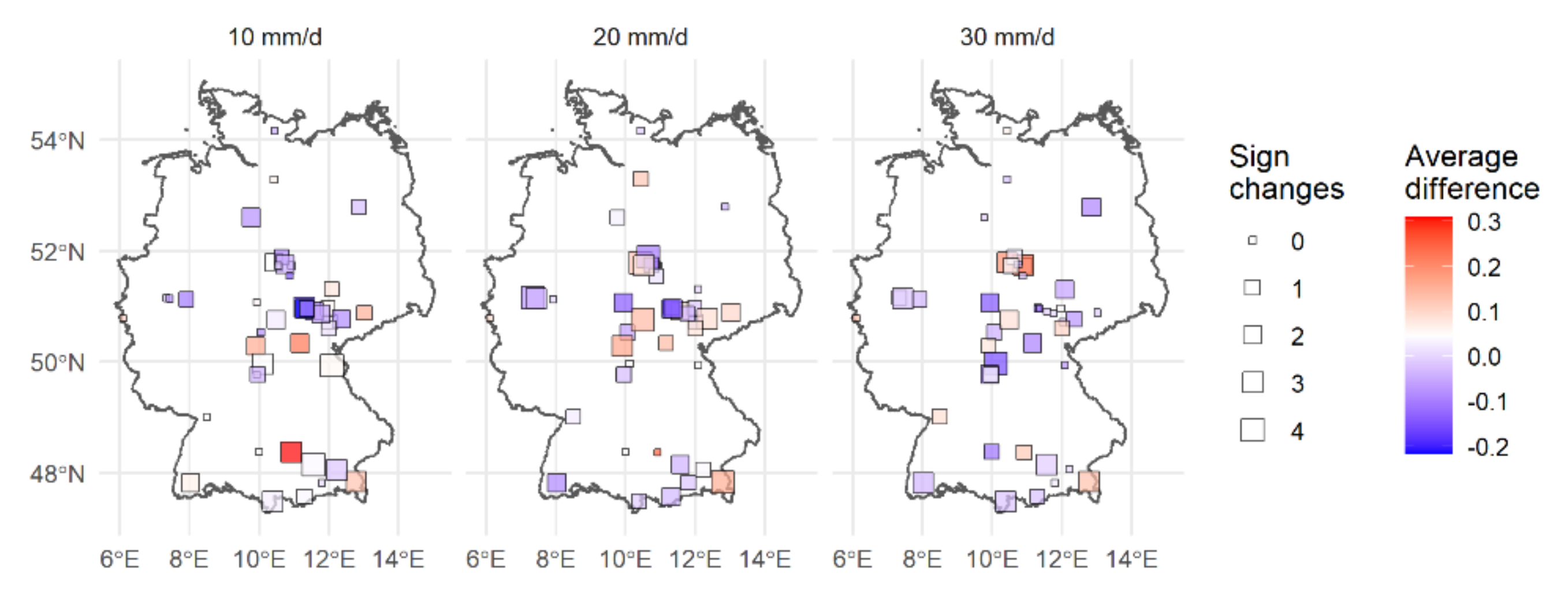
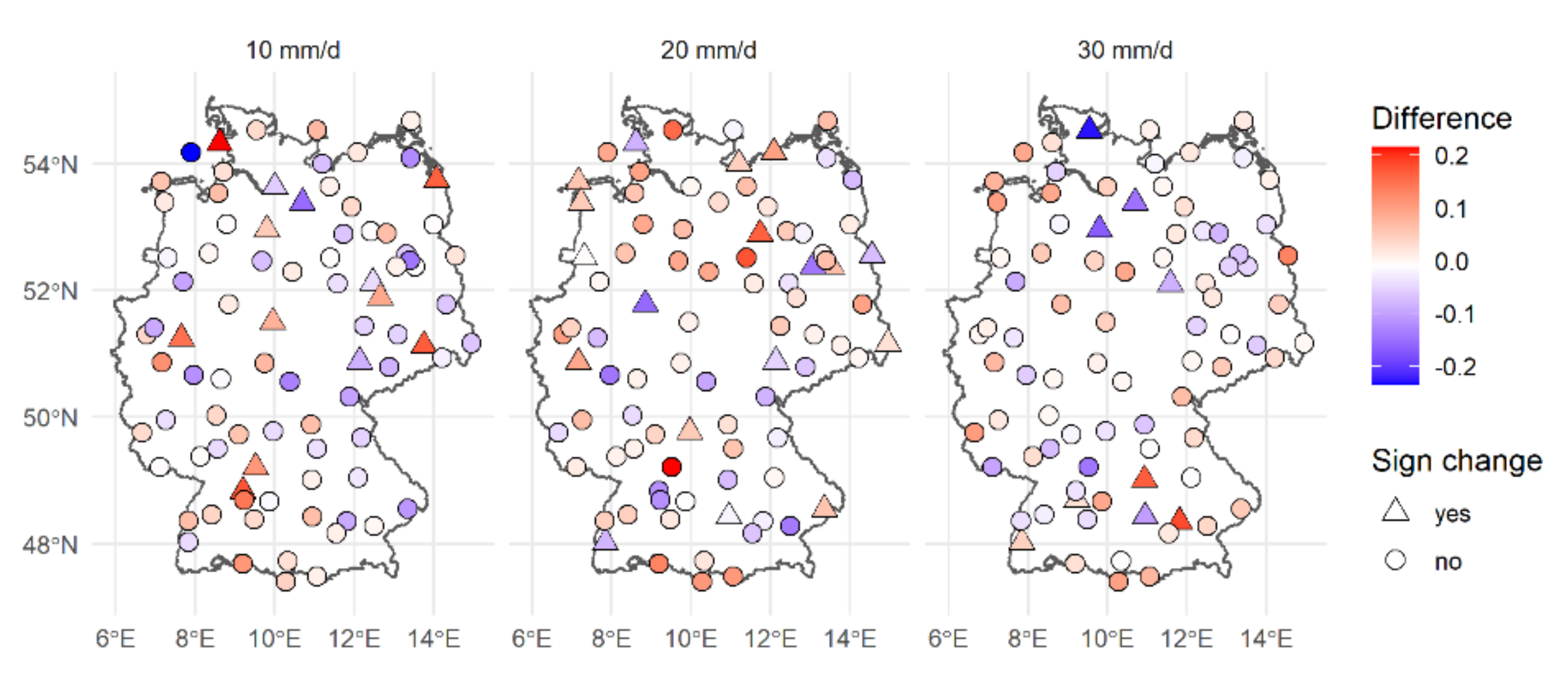
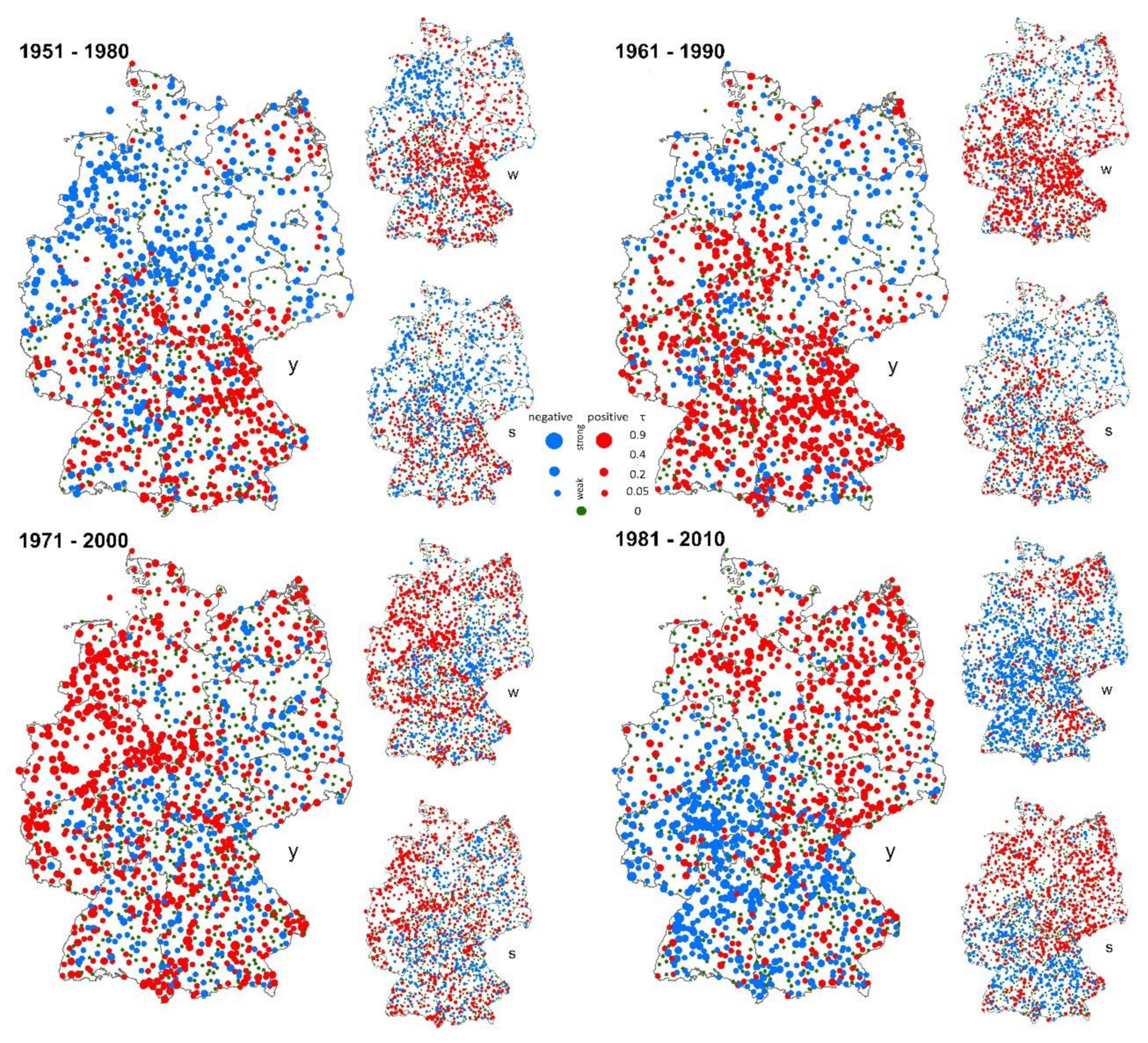
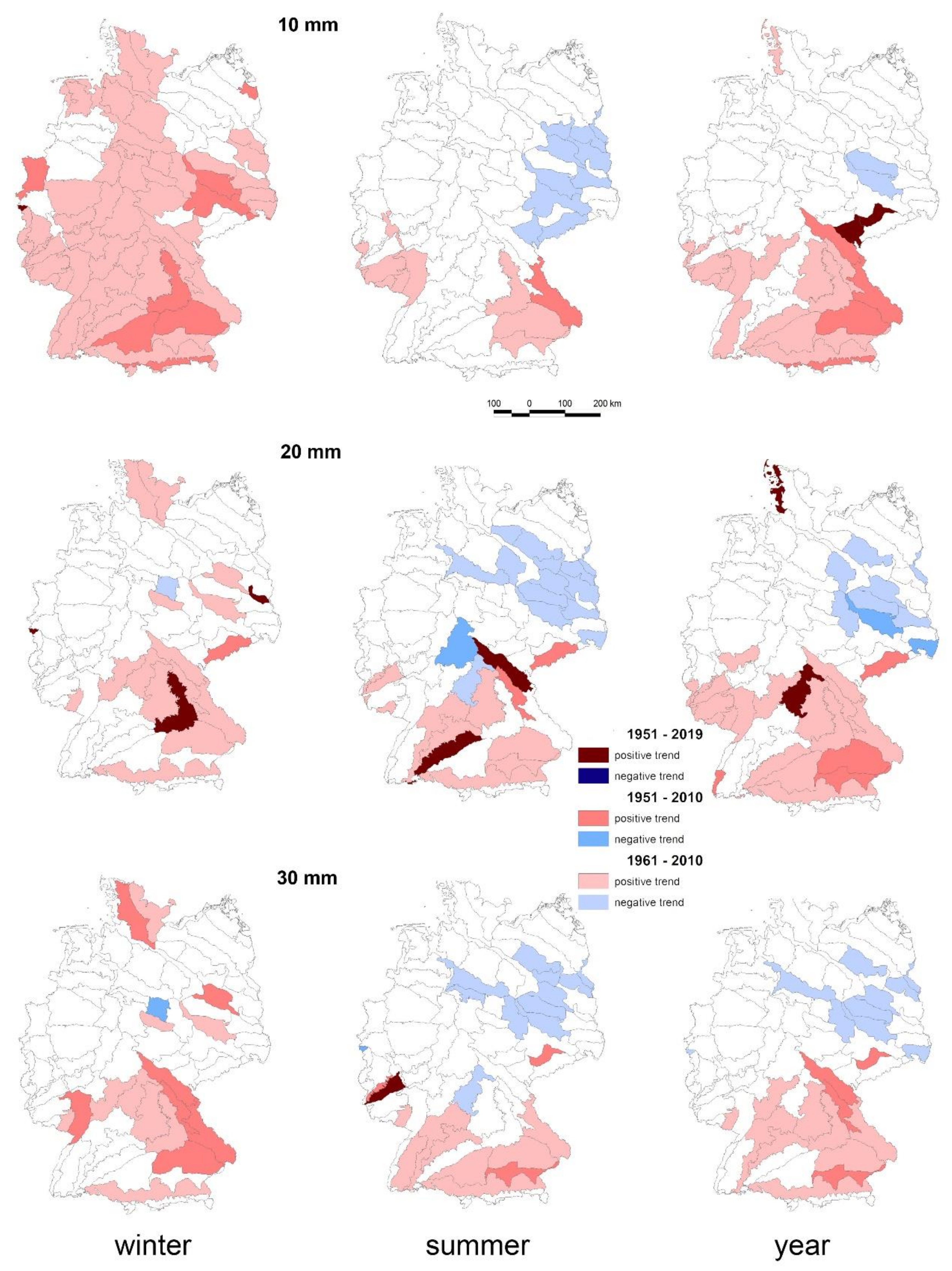


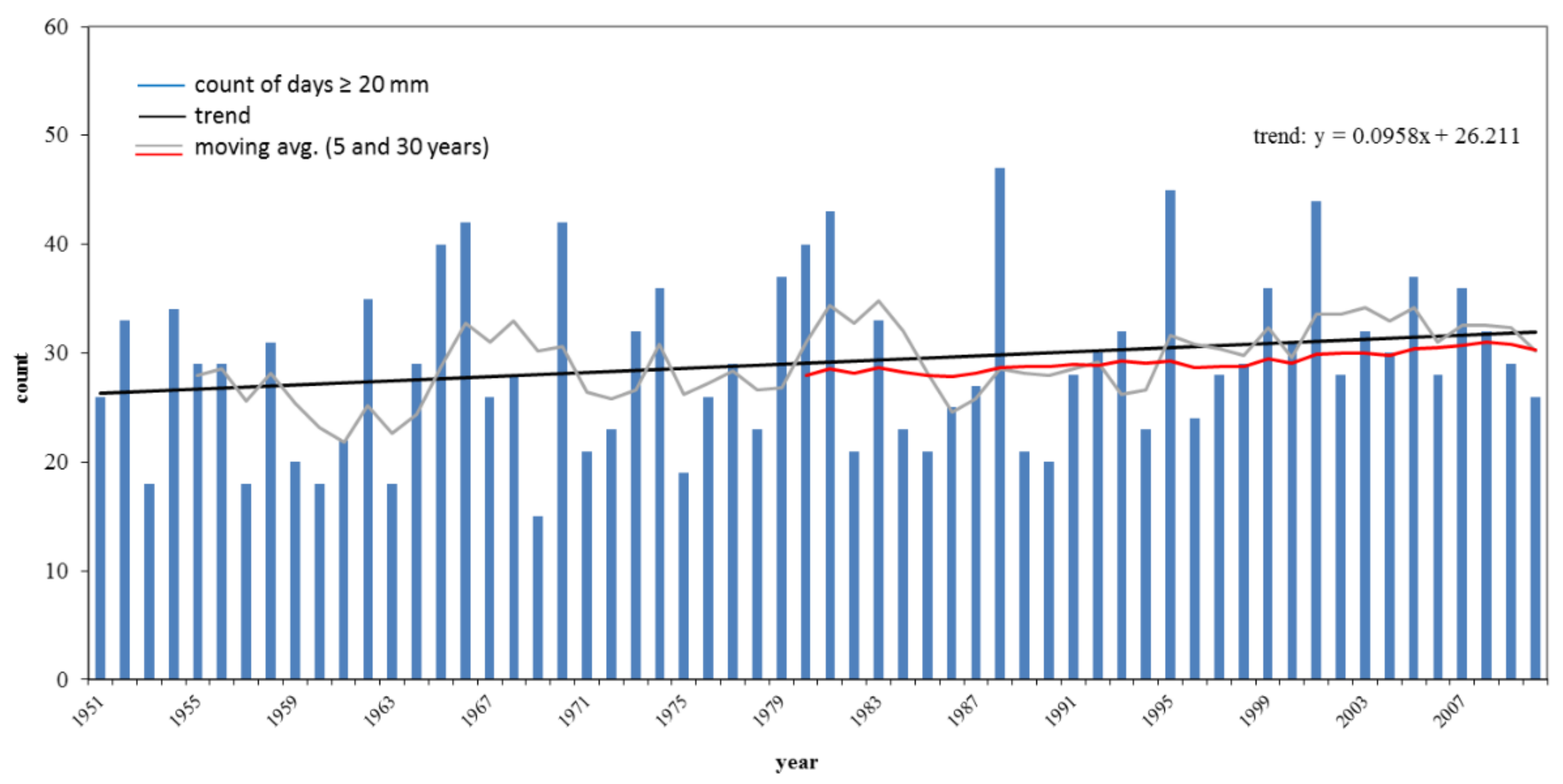
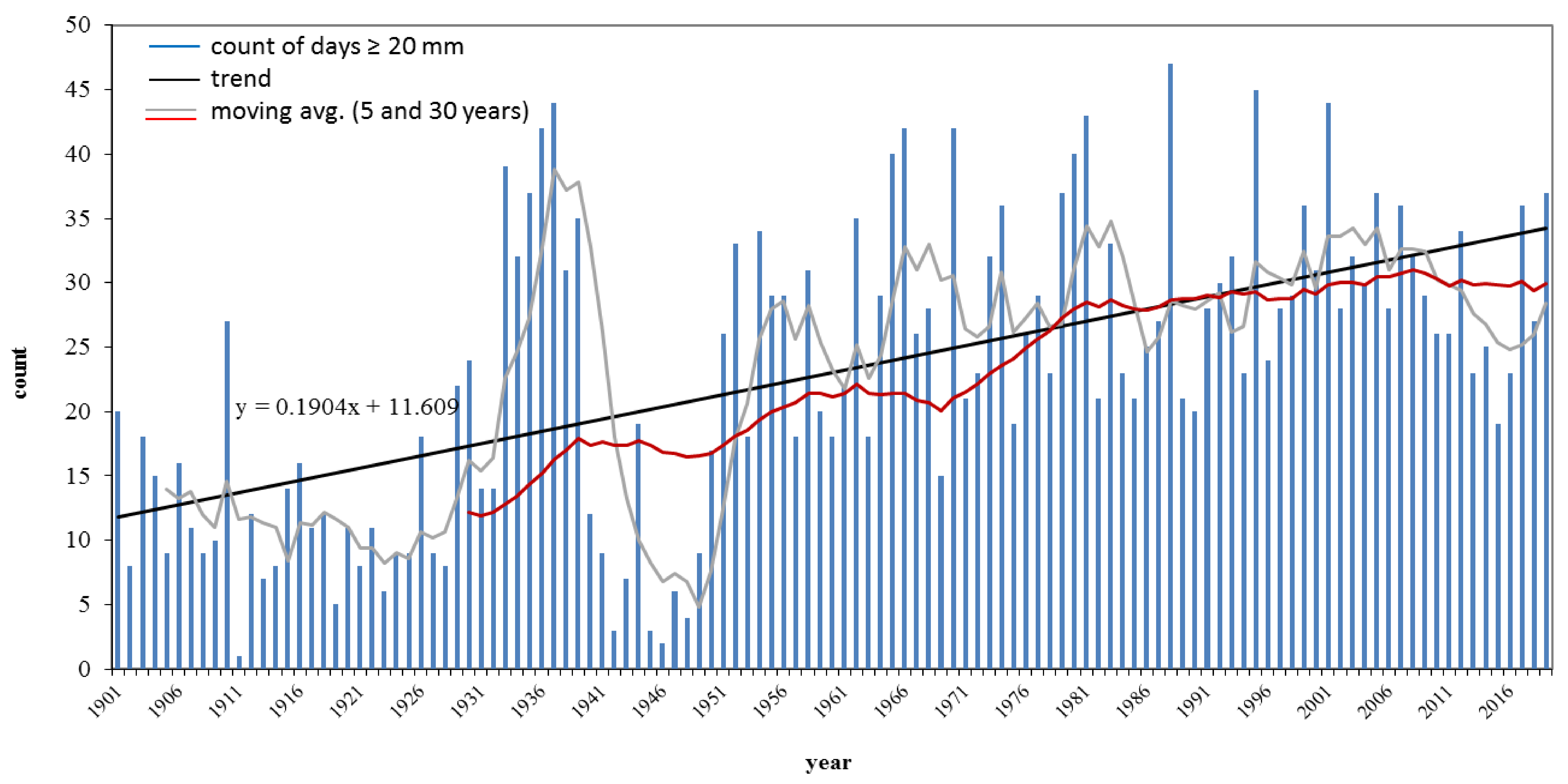

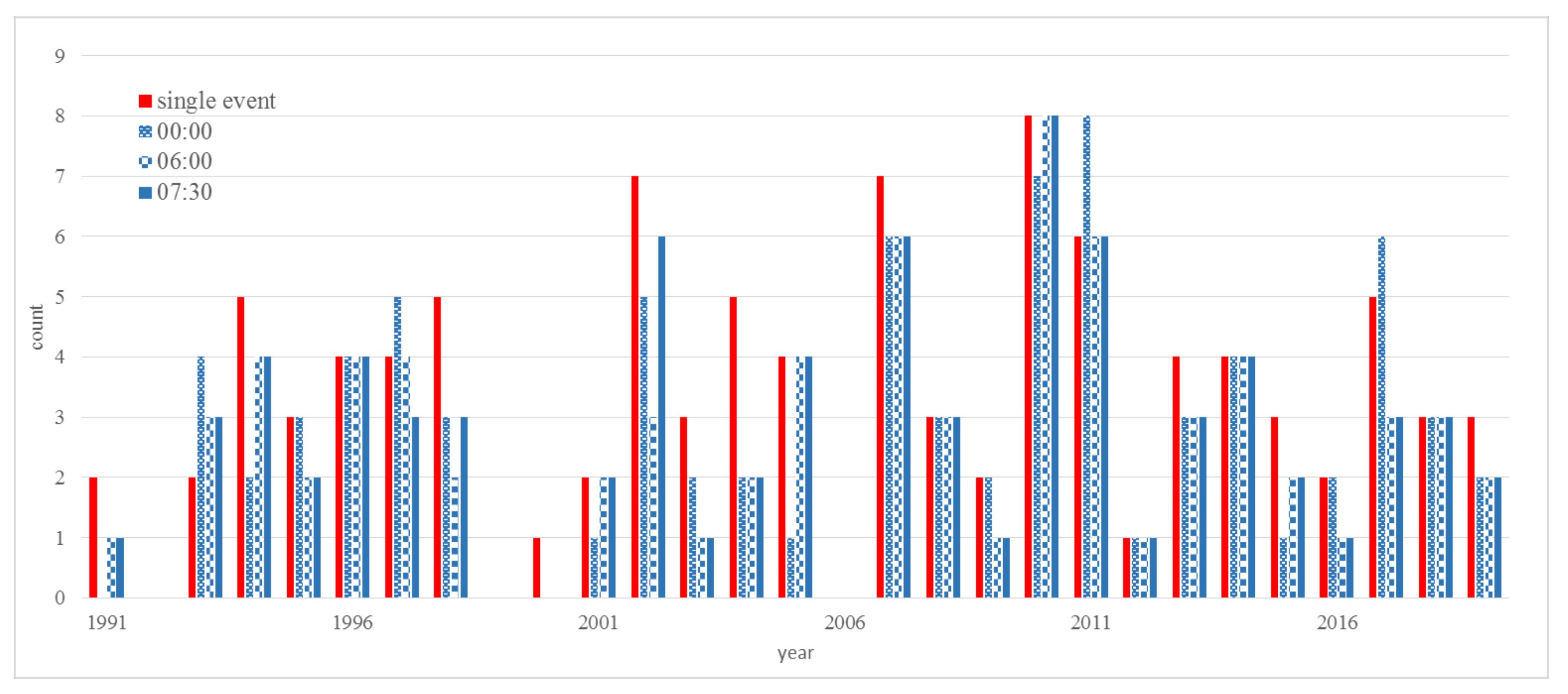


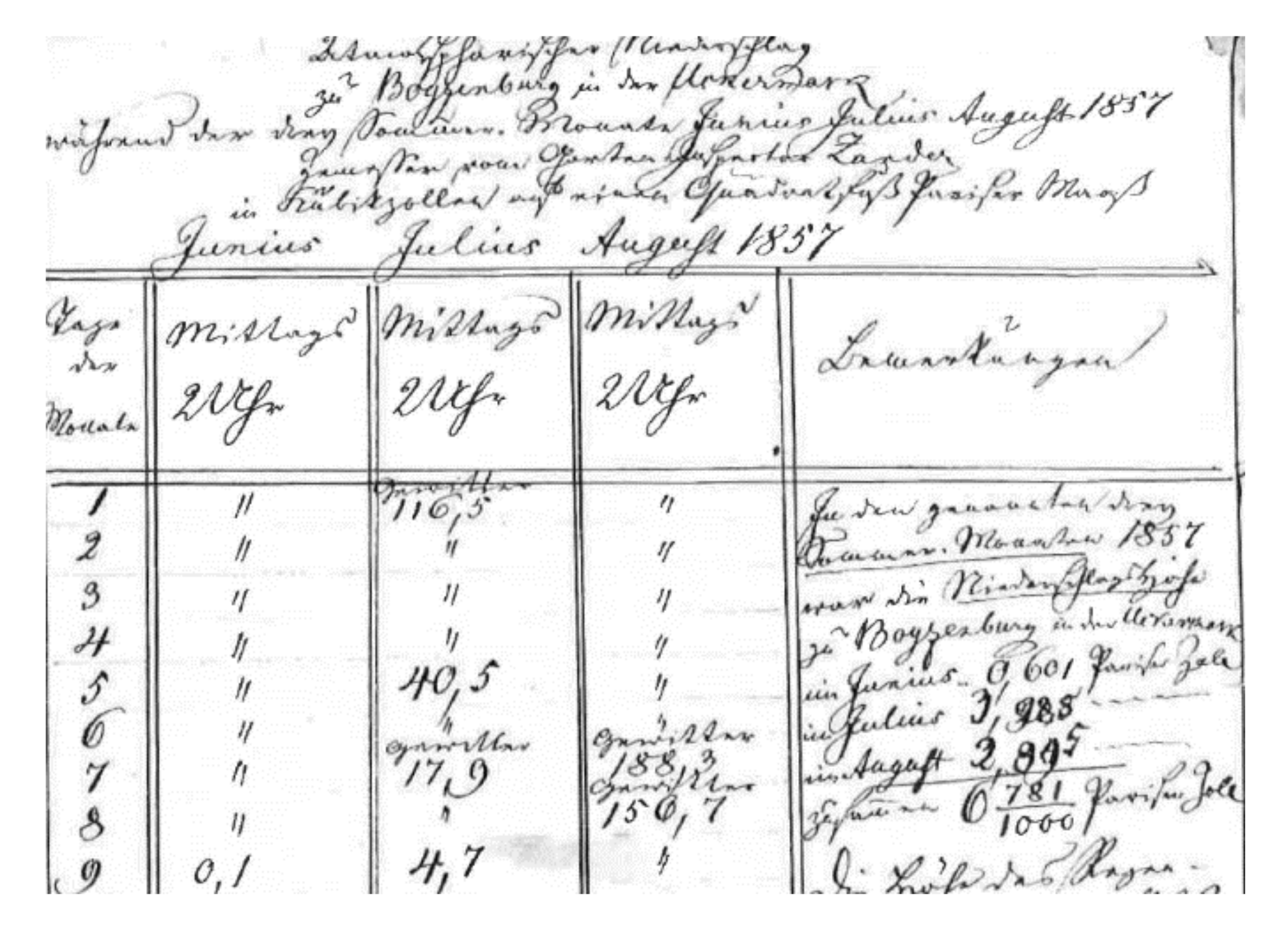
| Value | Stations with 9–10 Trend Values | Other Stations |
|---|---|---|
| Total number | 111 1 | 4552 |
| Shifts since instalment | 2.3 | 1.9 |
| Stations without shifts | 22 | 2450 |
| Distance (m), weighted mean 2 | 405 | 263 |
| Elevation (m), absolute change, weighted mean | 3.2 | 2.7 |
| CLINO Period | Threshold in mm d−1 |
|---|---|
| 1921–1950 | 10, 20, 30 |
| 1961–1990 | 30 |
| 1981–2010 | 10, 20 |
© 2020 by the authors. Licensee MDPI, Basel, Switzerland. This article is an open access article distributed under the terms and conditions of the Creative Commons Attribution (CC BY) license (http://creativecommons.org/licenses/by/4.0/).
Share and Cite
Deumlich, D.; Gericke, A. Frequency Trend Analysis of Heavy Rainfall Days for Germany. Water 2020, 12, 1950. https://doi.org/10.3390/w12071950
Deumlich D, Gericke A. Frequency Trend Analysis of Heavy Rainfall Days for Germany. Water. 2020; 12(7):1950. https://doi.org/10.3390/w12071950
Chicago/Turabian StyleDeumlich, Detlef, and Andreas Gericke. 2020. "Frequency Trend Analysis of Heavy Rainfall Days for Germany" Water 12, no. 7: 1950. https://doi.org/10.3390/w12071950
APA StyleDeumlich, D., & Gericke, A. (2020). Frequency Trend Analysis of Heavy Rainfall Days for Germany. Water, 12(7), 1950. https://doi.org/10.3390/w12071950





